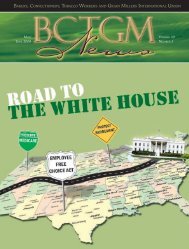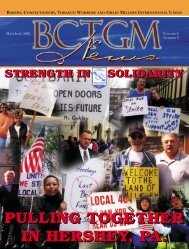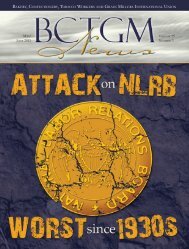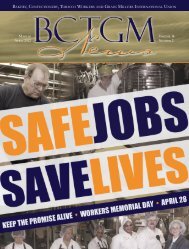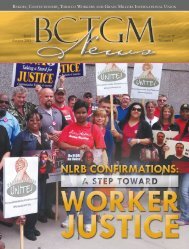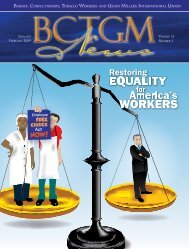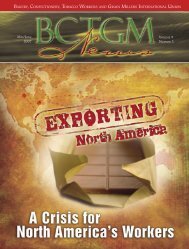to view/print. - Bakery, Confectionery, Tobacco Workers and Grain ...
to view/print. - Bakery, Confectionery, Tobacco Workers and Grain ...
to view/print. - Bakery, Confectionery, Tobacco Workers and Grain ...
You also want an ePaper? Increase the reach of your titles
YUMPU automatically turns print PDFs into web optimized ePapers that Google loves.
The Origins of<br />
In Canada, large public demonstrations of worker solidarity<br />
occurred in the early 1870s, linked <strong>to</strong> the struggle for the<br />
nine hour workday, <strong>and</strong> the fight <strong>to</strong> overturn Canadian<br />
laws that outlawed strikes, br<strong>and</strong>ed unions as “criminal<br />
conspiracies” <strong>and</strong> treated strike organizers as criminals.<br />
Large rallies <strong>and</strong> parades were<br />
organized in Ottawa <strong>and</strong> Toron<strong>to</strong><br />
in the spring <strong>and</strong> fall of 1872 <strong>to</strong><br />
support 24 jailed union activists—<br />
members of the Toron<strong>to</strong><br />
Typographical Union on strike for<br />
a shorter workday. The Toron<strong>to</strong><br />
parade drew <strong>and</strong> estimated 10,000<br />
people.<br />
The Ottawa parade stretched<br />
more than a mile, accompanied by<br />
an artillery b<strong>and</strong> <strong>and</strong> city firemen.<br />
The marchers made their way <strong>to</strong><br />
the home of Sir John A.<br />
MacDonald, hoisted him in<strong>to</strong> a<br />
carriage <strong>and</strong> <strong>to</strong>ok him <strong>to</strong> Ottawa<br />
City hall, where he promised the<br />
crowd he would repeal laws<br />
outlawing trade unions.<br />
MacDonald delivered on his<br />
commitment within the year.<br />
Dem<strong>and</strong>s for a shorter work<br />
week grew over the next decade,<br />
as parades, rallies <strong>and</strong> demonstrations<br />
became annual events in<br />
Canada <strong>and</strong> the United States,<br />
sponsored by a variety of unions<br />
<strong>and</strong> labour federations.<br />
In 1882, the American labor<br />
leader Peter McGuire was invited<br />
<strong>to</strong> speak at a labour rally in<br />
Toron<strong>to</strong>, <strong>and</strong> on his return <strong>to</strong> New<br />
York organized the first American<br />
Labor Day on September 5, 1882.<br />
The “father” of Labor Day, as well<br />
as the founder of the United<br />
Labour Day in Canada<br />
Brotherhood of Carpenters <strong>and</strong><br />
Joiners of America, McGuire was<br />
one of the most noteworthy figures<br />
in the his<strong>to</strong>ry of the American<br />
labor movement.<br />
As pressure for changes in<br />
work rules increased, so did<br />
conflicts with employers <strong>and</strong> the<br />
state. In 1864, the Federation of<br />
Organized Trades <strong>and</strong> Labour<br />
Unions of the U.S. <strong>and</strong> Canada<br />
established May 1, 1886 as a<br />
deadline for securing laws <strong>to</strong><br />
shorten the workday <strong>and</strong> began<br />
mobilizing.<br />
The International Working<br />
People’s Association planned a<br />
general strike in cities across the<br />
U.S. The Chicago event was<br />
marked by violence <strong>and</strong> in the<br />
days that followed there were<br />
demonstrations <strong>and</strong> a riot in<br />
Haymarket Square against police<br />
violence, coercion, <strong>and</strong><br />
provocation.<br />
Socialist workers’ movements<br />
in Engl<strong>and</strong> <strong>and</strong> Europe were also<br />
agitating for workers’ rights, <strong>and</strong><br />
proposing that a special day be<br />
proclaimed <strong>to</strong> underline dem<strong>and</strong>s<br />
for justice for the working class in<br />
industrial society. In 1889, the<br />
international socialist delegates<br />
meeting in Paris chose May 1st as<br />
Labour Day.<br />
Dem<strong>and</strong> was also increasing<br />
in the U.S. <strong>and</strong> Canada for a<br />
statu<strong>to</strong>ry holiday recognizing the<br />
rights <strong>and</strong> contribution of workers.<br />
In 1888, U.S. President Grover<br />
Clevel<strong>and</strong> established Labor Day<br />
– but fearing that a May 1st date<br />
would commemorate the<br />
Haymarket Riots two years earlier<br />
<strong>and</strong> strengthen the socialist<br />
movement in the U.S., President<br />
Clevel<strong>and</strong> chose <strong>to</strong> establish Labor<br />
Day in September –the date of the<br />
New York parades organized since<br />
1872 by the less radical Knights of<br />
Labor. Canada followed suit in<br />
1894, choosing early September for<br />
the national statu<strong>to</strong>ry holiday.<br />
The desire by American <strong>and</strong><br />
Canadian governments <strong>to</strong> isolate<br />
workers in North America from<br />
radical socialist movements of<br />
Europe is the reason we honor<br />
workers on the first weekend in<br />
September, while the rest of the<br />
world celebrates in solidarity on<br />
May 1st.<br />
Edi<strong>to</strong>rs Note: This article was published in the<br />
August 2007 issue of The Provincial, a publication<br />
of the B.C. Government <strong>and</strong> Service Employees’<br />
Union (BCGEU).<br />
September/Oc<strong>to</strong>ber 2007 www.bctgm.org 13



